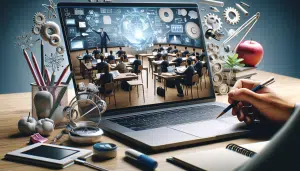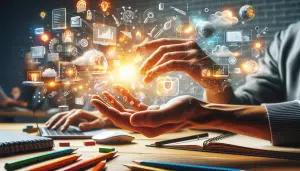Is Remote Learning Making Education More Equal
Lily Carter September 20, 2025
Remote learning has reshaped how millions access education, making it vital to explore its true impact. This guide examines whether online classes have succeeded in bridging gaps or are deepening divides, offering insights for parents, students, and educators navigating this evolving landscape.
Understanding the Rise of Remote Learning
Remote learning has experienced dramatic growth, reaching students from primary grades to college. The shift towards online classes began as a necessity, yet it quickly became a widespread phenomenon that continues to impact education systems globally. Schools and universities turned to digital platforms, hoping to maintain instructional quality and student engagement even outside traditional classrooms. Platforms like virtual classrooms, video lectures, and discussion forums became central for millions, allowing students to keep up with their academic paths from almost any location. The hope was that these new tools could democratize learning, offering flexibility some never enjoyed before.
Behind the rapid adoption lies a powerful potential. Digital access means students in rural or underserved communities—where high-quality educators or advanced courses were scarce—can participate in lessons otherwise unavailable to them. This process can help diminish educational barriers. Educational technology tools enable individuals to engage with diverse instructional materials, interactive exercises, and real-time support. But the scale of access remains a pressing concern. Not every home has the technology, internet connection, or parental support required for effective online participation, which can influence outcomes and equity.
As the world adjusts to this hybrid and remote learning landscape, it’s clear that effective online education depends on more than uploading worksheets. Thoughtful curriculum design, skilled instructors familiar with digital teaching, and robust support systems are all essential ingredients. The role of education technology in reshaping content delivery is huge, but it cannot replace human connection or individualized feedback. To really work for everyone, remote learning needs both high-quality infrastructure and continued teacher involvement. These early lessons have important implications for building more equitable systems.
Examining Educational Equity in Online Learning
One hope for remote learning was leveling the playing field, but achieving educational equity is complex. Equity in education means every learner, regardless of socioeconomic background or geography, receives the support necessary to succeed. In theory, online classes could benefit students in underfunded schools by offering access to specialized courses, advanced placement programs, or extracurricular enrichment they might otherwise miss. Resources from renowned organizations can be delivered remotely to those who need them most.
The reality is less clear-cut. The so-called digital divide—differences in internet speed, device quality, and technical skills—can reinforce old inequities. For students with reliable laptops, quiet study spaces, and internet access, online classes are a window to opportunity. Those without these advantages face additional hurdles, such as sharing devices with siblings or relying on unreliable mobile data. Closing this gap requires more than innovative platforms; it demands intentional policy, funding, and outreach at all levels of society.
Efforts to close the gap are underway. Some districts have issued devices, partnered with telecommunications firms, or offered hotspot access to low-income homes. There are also open online resource libraries and free courses from nonprofits, broadening access beyond traditional paywalls. Addressing educational equity is an ongoing process. Sustained attention from educators, policymakers, and communities is required to ensure every child can benefit equally from digital learning environments, regardless of ZIP code or family income.
Remote Learning and Special Education Needs
Remote learning presents unique challenges and opportunities for students with special education needs. For some, digital platforms offer customizable learning experiences—such as adjustable text sizes, closed captioning, or audio support—providing essential flexibility not always available in traditional classrooms. Adaptive technology allows material to be presented in diverse formats, catering to a wide range of learning styles and requirements. This can make learning more accessible for individuals who may have struggled in a conventional setting.
However, education for students with disabilities often relies on direct, hands-on instruction and specialized support, such as speech or occupational therapy. Online classes can make it difficult to maintain these personal, tailored interactions. The lack of physical presence might also hinder social development or cause students to feel isolated. Parents and caregivers frequently assume new roles as facilitators, which can feel overwhelming without adequate guidance or respite resources.
Policymakers and education leaders are working to expand accessibility through better training for teachers and more robust digital tools. Some programs now offer virtual one-on-one tutoring, teletherapy, or tailored supports for diverse learners. Ensuring remote learning is inclusive means ongoing investment in teacher development, family engagement, and user-friendly platforms. When these measures align, online education can become more welcoming, fostering both independence and achievement for students with unique needs.
The Social Impact of Online Education
The move from in-person classes to remote learning has changed social development dynamics. School is often about more than lessons—it’s a space for teamwork, friendship, and self-discovery. In online environments, these spontaneous moments are harder to recreate. Video calls facilitate communication but limit body language, side conversations, and the unstructured play that fosters emotional intelligence and social problem-solving in youth.
Online group projects and discussion boards offer some compensation, encouraging collaboration across distances. Clubs and student organizations have also shifted online, using chat platforms and video calls to maintain a sense of community. Yet, the risk of social isolation and digital fatigue remains. Students who thrive on peer interactions might find remote learning more taxing, while those affected by bullying or exclusion in physical schools may feel some relief in the digital space.
Building supportive networks requires attention from educators and caregivers alike. Mental health services adapted for digital delivery, online counseling, and virtual peer mentoring can mitigate some negative impacts. The social side of education is crucial for holistic development, pushing schools to innovate ways of promoting healthy online communities and a supportive atmosphere for all learners, regardless of background.
Assessing Academic Performance in Virtual Classrooms
How do students fare academically in remote learning? Studies show mixed results. Some learners, especially self-motivated or tech-savvy individuals, excel with the flexibility of online classes. Others struggle without in-person encouragement, clear routines, or frequent feedback. Differences in home environments and parental support also factor in, making broad generalizations difficult. Standardized testing and assessment methods have had to evolve quickly to reflect the realities of digital instruction.
One advantage of digital learning is the vast array of educational technology tools now used for tracking progress. Online quizzes, instant feedback, and interactive math or science simulations can help reinforce concepts and address gaps quickly. Teachers can monitor participation and adapt instruction based on individual student data in real time, which can make interventions more targeted and timely than before. Privacy and data security should remain central, safeguarding student information while leveraging analytics for improvement.
The shift has also exposed disparities. Students lacking support may fall behind, while advanced learners sometimes finish content ahead of schedule. Interventions must be flexible—ranging from additional tutoring hours to adjusting curriculum pacing. Development of fair grading systems that account for diverse home circumstances is an evolving challenge. Long-term, rigorous research helps educators refine digital education so that online classrooms deliver the best possible outcomes for everyone—not just the most advantaged.
Future Trends in Remote and Hybrid Education
Where is remote learning heading next? Many educators predict a future that blends physical classrooms with online components—a hybrid model. This approach offers flexibility, combining best practices from both digital and traditional settings. Schools can personalize learning, allowing students to move at their own pace while retaining in-person mentorship, laboratory access, and social experiences fundamental to education. Such models widen accessibility and give teachers new strategies to engage and motivate learners.
Emerging education technology, including artificial intelligence, adaptive learning software, and virtual reality, promises even richer experiences. These innovations can simulate real-life scenarios or provide individualized tutoring, supporting both struggling and advanced learners. Teachers and administrators are exploring how to adopt technology without losing the trust, empathy, and adaptability that only humans provide. Ongoing professional development and infrastructure will be essential as models evolve.
Evidence points to a future in which remote and hybrid options coexist, offering families more choices tailored to their needs. Attention must stay fixed on the principles of educational equity and access, so technology lifts all learners. Open discourse, strong research, and commitments from both public and private sectors will shape whether remote learning meets its egalitarian promise, empowering students far into the future.
References
1. National Center for Education Statistics. (n.d.). Students’ Access to Digital Learning Resources Outside of the Classroom. Retrieved from https://nces.ed.gov/pubs2017/2017098/index.asp
2. U.S. Department of Education, Office of Educational Technology. (n.d.). Reimagining the Role of Technology in Education. Retrieved from https://tech.ed.gov/files/2017/01/NETP17.pdf
3. The Brookings Institution. (n.d.). How the COVID-19 pandemic is reshaping education. Retrieved from https://www.brookings.edu/articles/how-covid-19-is-changing-education/
4. UNESCO. (n.d.). Distance learning strategies in response to COVID-19 school closures. Retrieved from https://en.unesco.org/covid19/educationresponse/solutions
5. Education Week. (n.d.). Remote Learning and Students With Disabilities: Lessons From the Field. Retrieved from https://www.edweek.org/teaching-learning/remote-learning-and-students-with-disabilities-lessons-from-the-field/2020/10
6. Harvard Graduate School of Education. (n.d.). The Social Side of Learning Goes Digital. Retrieved from https://www.gse.harvard.edu/news/uk/21/04/social-side-learning-goes-digital







